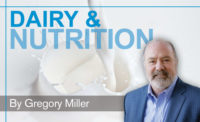The future of food
As the world population grows, there is a true need to find balance between efficient food production and responsible practices. This will require technology and innovation to help us feed a staggering 9 billion people by 2050. But food security is not only a 2050 challenge, it’s a 2013 challenge. Although the prevalence of overweight and obesity are at an all-time high, many also are undernourished; they are not getting adequate nutrition from the foods they eat. Still more face undernourishment because they simply do not have enough to eat. Domestically, more than 50 million face food insecurity, including almost 1 in 4 children.
Achieving a healthy population is not only about having enough food but also about the quality of food. A shared commitment from within and outside the dairy industry can help make nutritious, sustainable food a reality.
Dairy: where good comes from
The U.S. dairy industry is uniquely positioned to help meet these expectations. Dairy farms and businesses have a long history of nourishing communities around the world while producing food responsibly. Today we are building on this heritage, preparing for a future that requires us to dramatically increase food production in a sustainable way — a way that nurtures healthy people, a healthy planet and healthy businesses.
“Good for you” begins with personal benefit, and there is widespread recognition of dairy’s importance for health and well-being. Dairy foods and beverages offer essential, high-quality nutrition for health in an abundant, convenient, affordable and great-tasting package. Dairy is a key source of protein and other nutrients in the diet, including many that Americans fall short on.
The work of the Dairy Research Institute and its partners, the National Dairy Council and the Innovation Center for U.S. Dairy (all established under the leadership of America’s dairy farmers), reflects the dairy industry’s commitment to discover innovative products and to educate people about cutting-edge research that supports the role of milk, cheese, yogurt and dairy ingredients in a healthy diet and a healthy environment.
Reducing environmental impacts
The dairy industry has become significantly more efficient over the last century. For example, Cornell University reported that to produce the same amount of milk, dairy today uses 90% less land, 65% less water and has a 63% lower carbon footprint than in 1944.
Innovations and technology continue to drive efficiencies that reduce environmental impact and deliver cost savings, too. For example:
- Leprino Foods saved approximately $218,000 in electricity costs annually by replacing metal halide fixtures throughout the plant with fluorescent lamps and sanitary-design fluorescent fixtures that provide the same or better light coverage.
- By focusing on key performance areas, Darigold has been able to improve water use by more than 13%. It recycles 50% of its waste and achieved a nearly 50% reduction in fuel usage per unit, equal to more than 216,000 gallons of diesel fuel annually.
Communicating our progress
Consumers and dairy buyers want to know about the progress that dairy farms and businesses are making. Organizations like Costco, Walmart, Unilever and Kraft are setting sustainability goals and asking their suppliers for information on sustainability indicators such as carbon footprint, energy efficiency and water use.
The Innovation Center for U.S. Dairy is developing the Stewardship and Sustainability Guide for U.S. Dairy. The guide is a voluntary framework for tracking and communicating progress of the environmental, economic and community contributions of dairy farms and businesses.
In May, the dairy industry participated in The Chicago Council on Global Affairs Global Agricultural Development Initiative 4th Annual Symposium and a subsequent event hosted by The Washington Post and National Dairy Council. Participating in forums like this allows dairy to demonstrate its commitment to nutrition security. Follow the discussion at www.DairyGood.org. For information and resources on nutrition and sustainability, visit USDairy.com.


